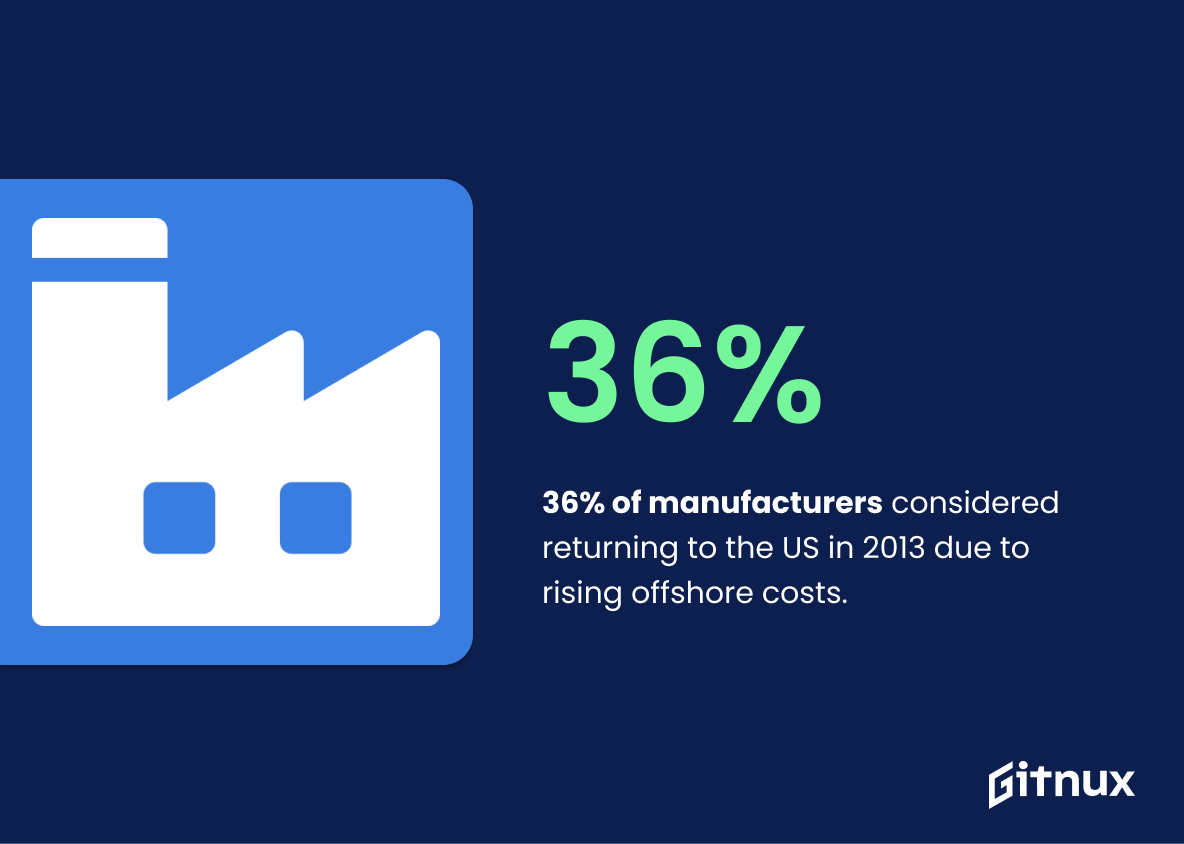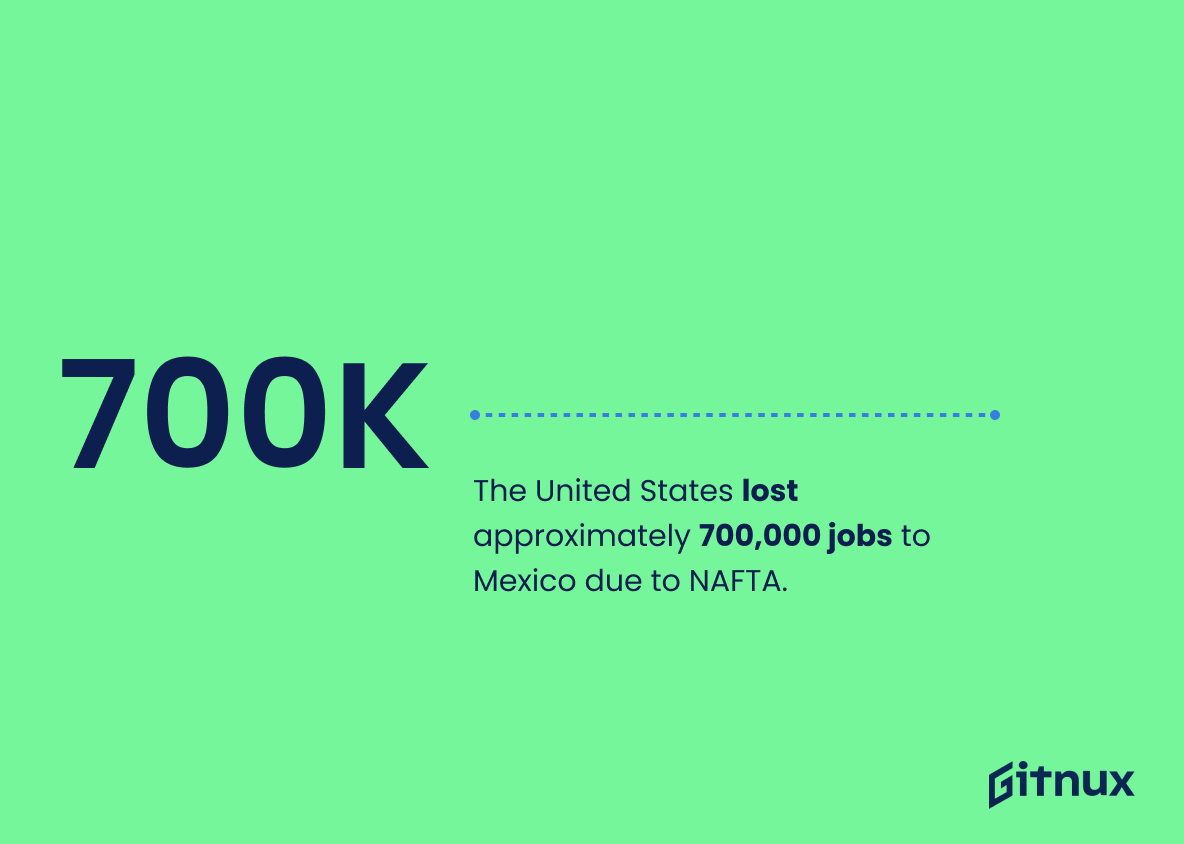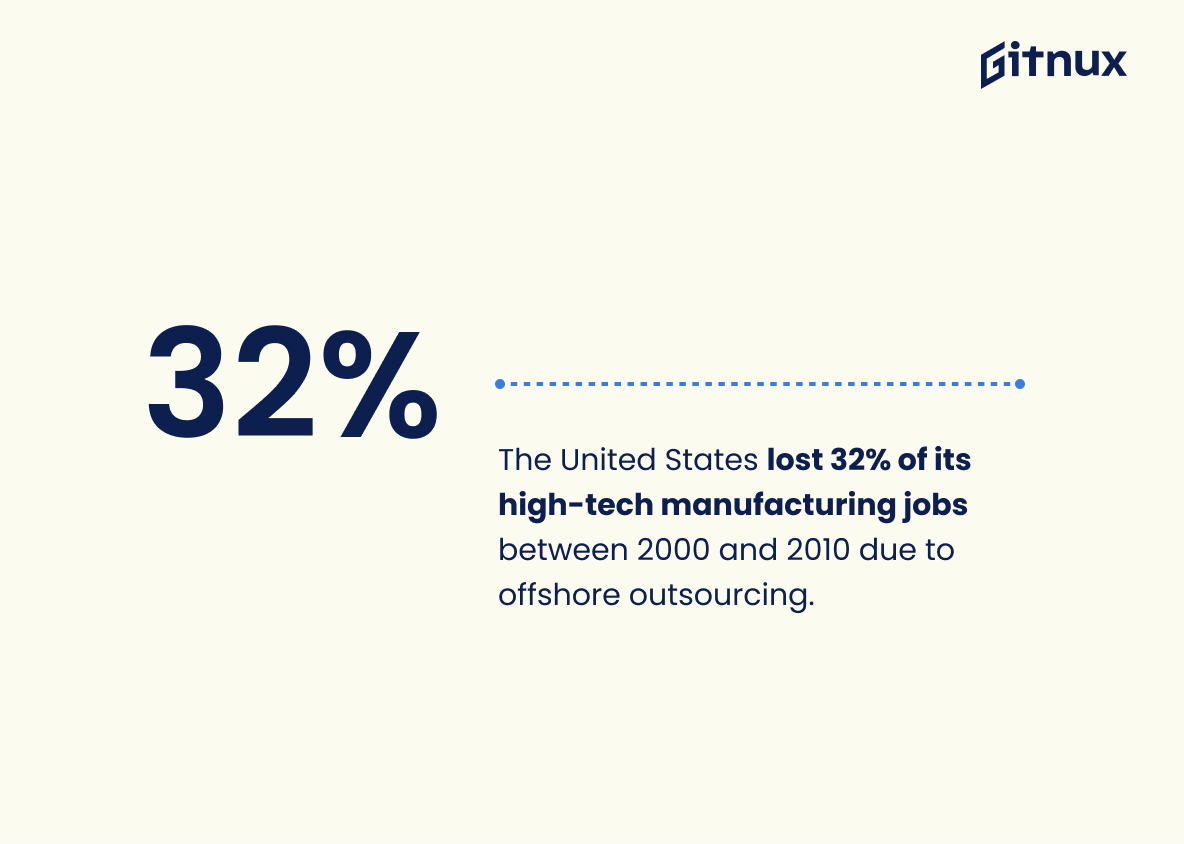The outsourcing of jobs from the United States to foreign countries has been a growing trend since 2001. According to research, approximately 2.7 million American jobs have been sent overseas in this time period alone. India, China and Malaysia are the top three countries receiving outsourced US jobs as of 2021. Additionally, 60% of multinational enterprises source goods and services overseas while 36% reported considering returning production back to the U.S due to rising offshore costs in 2013. Manufacturing job losses make up 80% of all job losses in America with China having 3.2 million U.S Jobs outsourced between 2001-2011; 700,000 were lost due to NAFTA specifically for Mexico alone. 20 percent of offshored jobs between 1983-2003 are IT Services related while over 150 thousand call center positions moved from 2007 -2013 into The Philippines . 32 percent manufacturing textile industry is located within china , 7 point seven percent (7%)of usa manufacturing was out sourced by 2016 & eighty %(80%) auto industry loss is attributed too outsourcing . 77percent it executives leverage lower cost through out sourcing projects 57percent off shoring done by USA firms relates too manufacuring processes 14million total USA firm’s off shore employment 1980 – present 81k average wage per year for those employed via Outsourcing 2000 compared 53K national avg salary that same year Finally an estimated 20 thousand monthly position move outside our borders each month .
This statistic is a stark reminder of the impact that outsourcing has had on the American job market. It paints a vivid picture of the millions of jobs that have been lost to foreign countries since 2001, highlighting the need for more effective policies to protect American jobs. It also serves as a warning to those considering outsourcing their own jobs, as it demonstrates the potential consequences of such a decision.
About 60% of multinational enterprises source goods and services overseas.
This statistic is a telling indication of the prevalence of jobs sent overseas. It highlights the fact that a large proportion of multinational enterprises are taking advantage of the cost savings associated with sourcing goods and services from abroad. This has a direct impact on the job market in the countries where these multinationals are based, as jobs are being lost to overseas markets.
Jobs Sent Overseas Statistics Overview
In 2013, around 36% of manufacturing companies reported considering returning production to the United States due to rising offshore costs.
This statistic is a telling indication of the impact of overseas costs on the manufacturing industry. It shows that a significant portion of companies are considering bringing production back to the United States, suggesting that the cost of doing business overseas is becoming too high for many companies. This is an important factor to consider when discussing the overall impact of jobs sent overseas, as it suggests that the trend may be reversing in some cases.
China has the largest number of U.S. jobs outsourced to it, at around 3.2 million. (2001-2011)
This statistic is a stark reminder of the impact that outsourcing has had on the U.S. job market. It highlights the fact that millions of jobs have been sent overseas to China, resulting in a significant loss of employment opportunities for American workers. This statistic is a powerful illustration of the need for the U.S. to take steps to protect its domestic job market and ensure that American workers are not disadvantaged by the outsourcing of jobs.
The United States lost approximately 700,000 jobs to Mexico due to NAFTA.
This statistic is a stark reminder of the impact that NAFTA has had on the US job market. It serves as a powerful illustration of the economic losses that have been incurred due to the agreement, and highlights the need for more effective policies to protect American jobs.
Over 150,000 call center jobs were outsourced from the U.S. to the Philippines from 2007 to 2013.
This statistic is a stark reminder of the impact of outsourcing on the U.S. job market. It highlights the fact that over 150,000 call center jobs were sent overseas in a six-year period, resulting in a significant loss of employment opportunities for American workers. This statistic is a powerful illustration of the economic consequences of outsourcing and serves as a reminder of the need to protect American jobs.
Approximately 32% of all outsourced manufacturing jobs in the textile industry are sent to China.
This statistic is a stark reminder of the impact of outsourcing on the textile industry. It highlights the fact that a significant portion of manufacturing jobs in the sector have been sent overseas, with China being the primary recipient. This has had a major impact on the industry, with many workers in the US and other countries losing their jobs as a result. It is a sobering reminder of the realities of globalization and the need for governments to take action to protect their domestic industries.
More than 80% of job losses in the US auto industry are related to outsourcing.
This statistic is a stark reminder of the impact outsourcing has had on the US auto industry. It highlights the fact that the majority of job losses in this sector are due to companies sending jobs overseas, rather than other factors such as automation or economic downturns. This statistic is a powerful illustration of the consequences of outsourcing and should be taken into account when considering the overall impact of this practice.
The annual wage for workers in outsourced jobs was about $81,300 in 2001, while the average pay for all jobs in the U.S. was about $53,100 that year.
This statistic paints a stark picture of the economic disparity between outsourced jobs and other jobs in the U.S. in 2001. It highlights the fact that outsourced jobs were paying significantly more than the average wage for all jobs in the U.S., indicating that these jobs were providing a much higher level of economic security than other jobs. This is an important point to consider when discussing the impact of jobs sent overseas, as it shows that these jobs can provide a much higher level of economic stability than other jobs in the U.S.
The United States lost 32% of its high-tech manufacturing jobs between 2000 and 2010 due to offshore outsourcing.
This statistic is a stark reminder of the impact that offshore outsourcing has had on the United States’ high-tech manufacturing sector. It highlights the fact that thousands of jobs have been lost in this sector over the past decade, and serves as a warning of the potential consequences of continuing to outsource jobs overseas.
One estimate suggests that around 20,000 jobs are offshored per month by U.S. firms.
This statistic is a stark reminder of the impact that offshoring has on the U.S. job market. It highlights the fact that thousands of jobs are being sent overseas each month, which can have a significant impact on the economy and the livelihoods of those affected. It is a sobering reminder of the need to ensure that U.S. firms are held accountable for their offshoring practices and that measures are taken to protect American jobs.
Conclusion
In conclusion, the statistics presented in this blog post demonstrate that outsourcing of jobs from the United States to foreign countries has been a growing trend since 2001. India, China and Malaysia are currently receiving the most outsourced US jobs while manufacturing companies have considered returning production to America due to rising offshore costs. Manufacturing job losses make up 80% of all job losses in the USA with China having received 3.2 million U.S. jobs between 2001-2011 alone; Mexico also lost 700,000 jobs due to NAFTA and 20% of offshored positions were IT services related over 1983-2003 period . Additionally, 77% of IT executives plan on leveraging lower costs by outsourcing projects abroad while 57% is related to manufacturing processes and 32 % high tech manufacturing was lost 2000 -2010 as well as 14 million total since 1980s The average wage for workers in these outsourced positions was $81 300 compared with an overall national average at $53 100 per year during same time frame . It appears that despite some firms considering bringing back production domestically , there is still significant pressure towards sending more American Jobs overseas each month (20 000).
References
0. – https://www.brookings.edu
1. – https://www.siepr.stanford.edu
2. – https://www.mckinsey.com
3. – https://www.fas.org
4. – https://www.wikileaks.org
5. – https://www.cfr.org
6. – https://www.epi.org
7. – https://www.assemblymag.com
8. – https://www.accenture.com
9. – https://www.ustr.gov
ZipDo, cited June 2023: Jobs Sent Overseas Statistics









